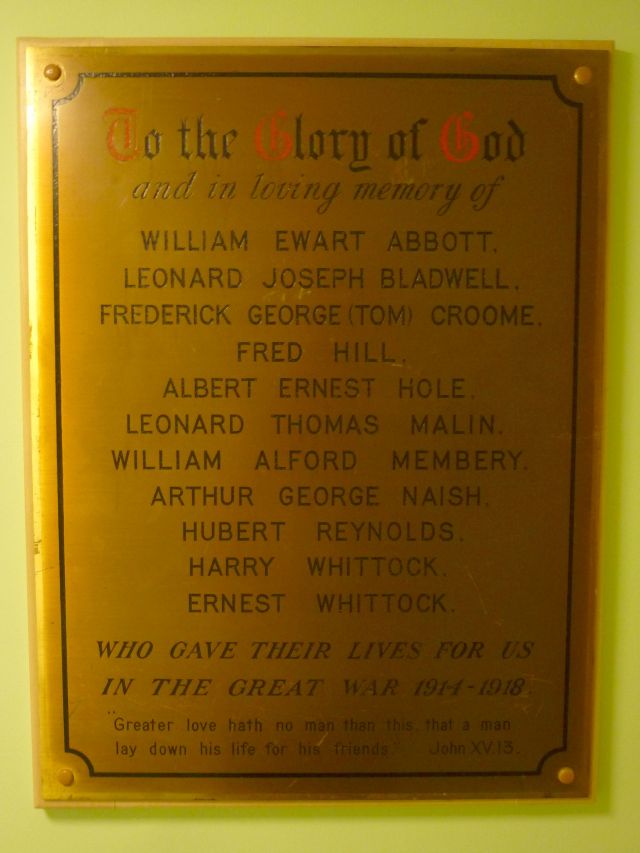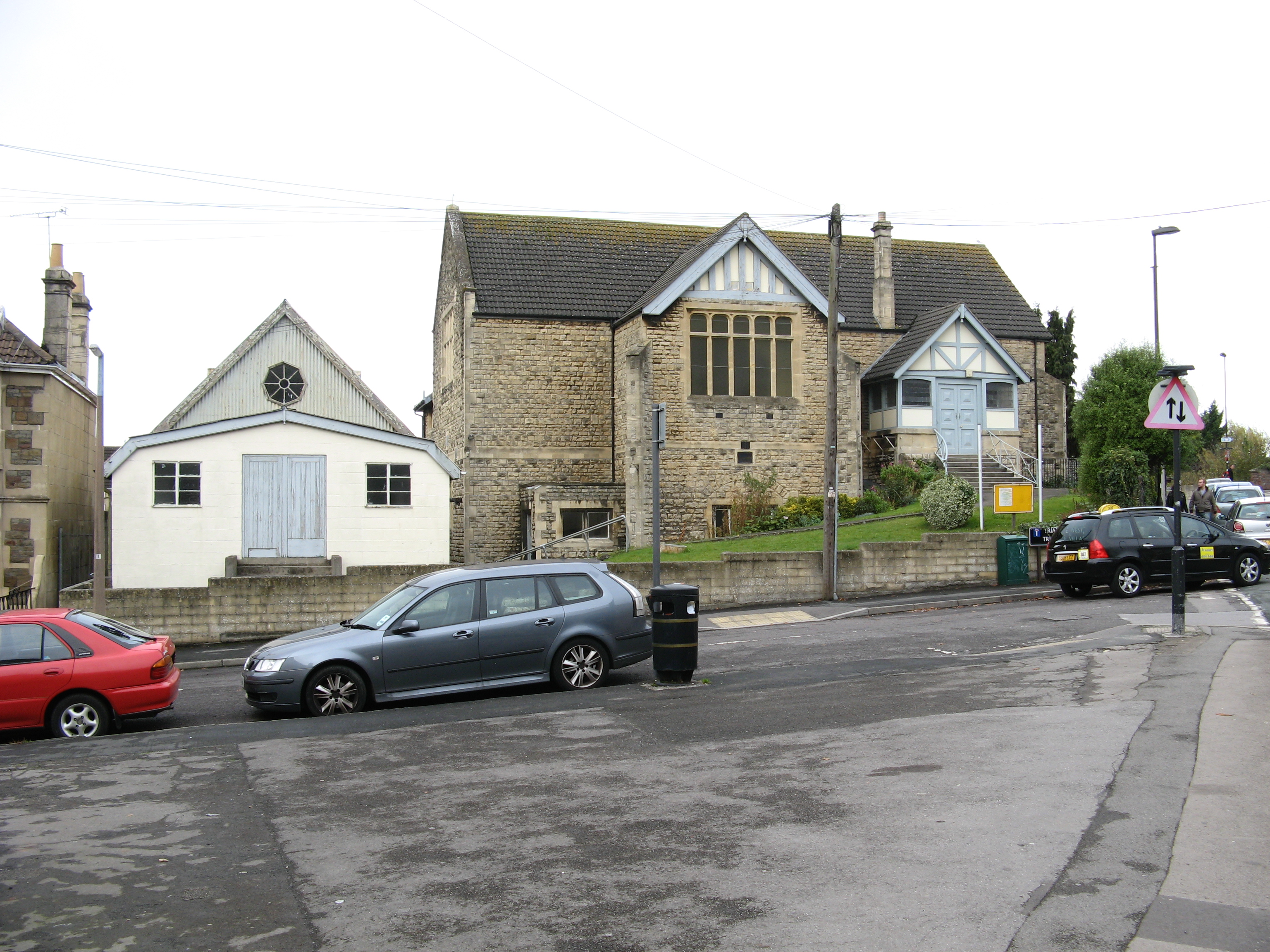Oldfield Park Junior School (Bath) WW1 Memorial Project
Oldfield Park Methodist Church (Bath)
WW1 Memorial
Now at Southdown Methodist Church, The Hollow
Oldfield Park Methodist Church stood at the western end of the Triangle but has now been converted into accommodation and the tin church hall has made way for a new house in the same style as existing houses in Triangle West.

The congregation has now joined its Methodist brethren at the 1950s Southdown Methodist Church at the top of the Hollow and this is where the memorial from Oldfield Baptist Church now resides. Sadly, the church has not seen fit to give the plaque a prominent position in either the body of the church or the vestibule. Instead it is tucked away in a back corridor, but my enquiry was met with a ready offer of assistance.
The church can be accessed around scheduled service times (with the usual respect for people preparing for service etc.) or other events and the church website is the best resource for knowing when these take place.
From Bath Chronicle & Weekly Gazette, Saturday 24th July 1920:
OLDFIELD PARK WESLEYANS
War Memorial Tablet Unveiled
War Memorial Tablet Unveiled
At
a special service on Sunday afternoon, the brass memorial tablet which
has been erected in the Oldfield Park Wesleyan Church in memory of the
eleven members who perished in the war was unveiled by Mrs. Robinson,
sister -of the Rev. J. Walthew Simister, Superintendent of the Bath
Circuit. The Rev. Vincent Taylor, B.D., was also present, and there was
a large attendance of church officers.
The service commenced with the hymn 'For all the Saints', and during its singing the choir, followed by the church officers and ministers, took their places near the memorial. Prior to the unveiling ceremony. Mrs. Robinson gave a sympathetic address. She expressed her solicitude for those bereaved parents and relatives who had formed plans for the future careers and success of those who had perished. As for the fallen, they had given their lives not only for their own homes, but to save, if possible, the homes of the dwellers in France and BeIgium. Mrs. Robinson described a pathetic incident which she personally witnessed when on a visit to the war-devastated region. Amid the desolaton, a woman was searchng for some trace of her ruined home, and eventually discovered two fragments of broken china ornaments, which were evidently as dear to her as jewels. She (the speaker) trusted that in the future history of the world those ideals of peace which were dear to such soldier poets as Rupert Brooke might prevail. Mrs. Robinson then unveiled the memorial, and read the names inscribed on the tablet.
After the hymn 'Hark! the sound of holy voices', the Rev. J. W. Simister gave an address. prefaced his remarks by reading a portion of Ecclesiasticus, Chapter 44, to which Mr. Rudyard Kipling called attention some months ago. They were glad, he remarked, to think that the names of the members of their own church who had perished were not without a memorial, but that the love and reverence of that church had provided a permanent commemoration in token of their appreciation. They had come that afternoon into the House of God, and it was their wish to dwell more on man's capacity for noble acts than on purely military achievement. He recognised, however, that in the hearts of the bereaved there was probably still little room for either philosophy or faith. He would remind his hearers as some measure of consolation that many men of distinguished talents had died in comparative youth, their life-work apparently still incomplete. Raphael died at the age 37, and Schubert, between 30 and 40. But while they deplored the apparently lessened tribute of talent owing to the loss of these young soldiers, they look comfort in the thought expressed by one of them that their experiences in warfare made them feel absolutely sure of the life beyond.
The concluding hymn was 'The Saints of God! their conflict past'.
The tablet bears the inscription:
The service commenced with the hymn 'For all the Saints', and during its singing the choir, followed by the church officers and ministers, took their places near the memorial. Prior to the unveiling ceremony. Mrs. Robinson gave a sympathetic address. She expressed her solicitude for those bereaved parents and relatives who had formed plans for the future careers and success of those who had perished. As for the fallen, they had given their lives not only for their own homes, but to save, if possible, the homes of the dwellers in France and BeIgium. Mrs. Robinson described a pathetic incident which she personally witnessed when on a visit to the war-devastated region. Amid the desolaton, a woman was searchng for some trace of her ruined home, and eventually discovered two fragments of broken china ornaments, which were evidently as dear to her as jewels. She (the speaker) trusted that in the future history of the world those ideals of peace which were dear to such soldier poets as Rupert Brooke might prevail. Mrs. Robinson then unveiled the memorial, and read the names inscribed on the tablet.
After the hymn 'Hark! the sound of holy voices', the Rev. J. W. Simister gave an address. prefaced his remarks by reading a portion of Ecclesiasticus, Chapter 44, to which Mr. Rudyard Kipling called attention some months ago. They were glad, he remarked, to think that the names of the members of their own church who had perished were not without a memorial, but that the love and reverence of that church had provided a permanent commemoration in token of their appreciation. They had come that afternoon into the House of God, and it was their wish to dwell more on man's capacity for noble acts than on purely military achievement. He recognised, however, that in the hearts of the bereaved there was probably still little room for either philosophy or faith. He would remind his hearers as some measure of consolation that many men of distinguished talents had died in comparative youth, their life-work apparently still incomplete. Raphael died at the age 37, and Schubert, between 30 and 40. But while they deplored the apparently lessened tribute of talent owing to the loss of these young soldiers, they look comfort in the thought expressed by one of them that their experiences in warfare made them feel absolutely sure of the life beyond.
The concluding hymn was 'The Saints of God! their conflict past'.
The tablet bears the inscription:
To the Glory of God
and in loving memory of
William. E. Abbott
Leonard J. Bladwell
F. G. (Tom) Croome
Fred Hill
Albert E. Hole
Leonard T. Malin
William A. Membery
Arthur G. Naish
Hubert Reynolds
Harry Wliittock
Ernest Whittock
who gave their lives for us
in the Great War. 1914-1918.
Greater love hath no man than this, that a man
lay down his life for his friends. John XV 13
and in loving memory of
William. E. Abbott
Leonard J. Bladwell
F. G. (Tom) Croome
Fred Hill
Albert E. Hole
Leonard T. Malin
William A. Membery
Arthur G. Naish
Hubert Reynolds
Harry Wliittock
Ernest Whittock
who gave their lives for us
in the Great War. 1914-1918.
Greater love hath no man than this, that a man
lay down his life for his friends. John XV 13
Southdown Methodist Church is also the repository of a marble tablet salvaged from New King Street Methodist Church which was destroyed in the Bath Blitz. The tablet commemorates the laying of the foundation stone of the original chapel on that site in the 18th century by John Wesley. It was a later (1847) iteration of the chapel that was destroyed. This tablet has, at least, made it into the vestibule of the Southdown church, where it can be viewed.